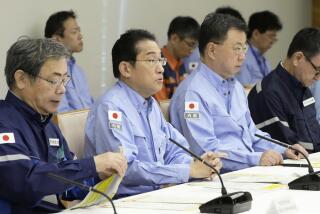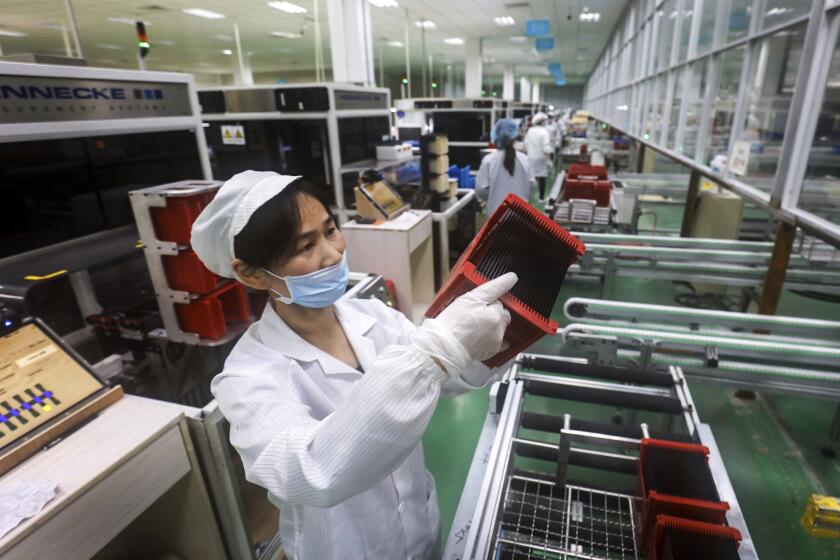Nakasone’s Visit to Wartime Shrine Criticized
- Share via
TOKYO — In a move condemned by Buddhists, Christians and Japan’s opposition parties, Prime Minister Yasuhiro Nakasone on Thursday became the first postwar Japanese leader to pay an official visit to Yasukuni Shrine, the headquarters of Japan’s wartime emperor-worship and militarism.
On the 40th anniversary of Japan’s surrender to the United States, Nakasone and 18 of his Cabinet ministers made official visits to the shrine to pray for peace and for the souls of the war dead after commemorating Japan’s war dead in a non-religious government ceremony also attended by Emperor Hirohito.
Nakasone’s decision to transform what previously had been private visits to the shrine into official ones--with funds from the national treasury used to pay for flowers--was the most controversial action he has taken so far to carry out a pledge to make a “final accounting” of the taboos of Japan’s postwar era.
Yasukuni Shrine, stripped of its official state support by U.S. occupation authorities and a postwar constitution requiring separation of religion and politics, still is considered to enshrine the souls of the more than 2.5 million servicemen who died in Japan’s 1931-1945 war against first China, and then the United States and most of Asia.
Among those honored there are the wartime prime minister, Gen. Hideki Tojo, and six others convicted as “Class A” criminals at the occupation-era Tokyo war crimes trials.
Coming out of the shrine, Nakasone told newsmen that he had signed the visitor book as “Prime Minister Yasuhiro Nakasone,” unlike previous visits, when he had signed as “a man named Yasuhiro Nakasone who is prime minister.” The Cabinet ministers also signed their names with their official titles.
Nakasone said, however, that he had not followed prescribed Shinto forms of worship in order to avoid “engaging in religious activity.”
“My visit in no way means a revival of militarism or of state Shintoism,” he declared.
Chief Cabinet Secretary Takao Fujinami explained that a 30,000 yen ($125) payment from state funds was made to the shrine for flowers purchased in Nakasone’s name.
Nakasone’s visit to the shrine brought a storm of protest, both domestic and foreign.
In Peking, a Foreign Ministry spokesman had said Wednesday--a day before the visit--that “an official visit to the Yasukuni Shrine, which commemorates a number of Japanese war criminals, would hurt the feelings of both the Chinese and Japanese peoples who suffered at the hands of the militarists.”
Radio Moscow also condemned the move, charging that it proved that there are militarist tendencies in Japanese government policy.
At home, Buddhist and Christian groups and all of the opposition parties protested the official visits. Article 20 of the constitution requires separation of politics and religion and Article 89 forbids state financial support for religious institutions.
In a speech last month, Nakasone, a World War II naval officer whose brother, Ryosuke, 25, also a naval officer, was killed during the war, said that “it is only natural that the people wish to express gratitude to those who have fallen in service to the nation. If not, who would give his life for the nation?” Fujinami, in announcing the policy change that would permit official visits to the shrine, said they were made “in response to the strong desire of many, including families of the war dead.” The Japanese government, he added, is “deeply conscious of the fact that Japan caused much pain and damage to many in Asia and elsewhere” during World War II but intended “simply to pay respect to the memory of those who died in war.”
Earlier, Emperor Hirohito, 84, entered the Budokan (Martial Arts) Hall to the strains of “Kimigayo,” the national anthem, to open a ceremony commemorating Japan’s war dead, including civilians. Shortly before noon, he approached the altar and, at the stroke of the hour, bowed with 8,000 participants--144 of them 80 or older--during one minute of silence.
More to Read
Sign up for Essential California
The most important California stories and recommendations in your inbox every morning.
You may occasionally receive promotional content from the Los Angeles Times.










